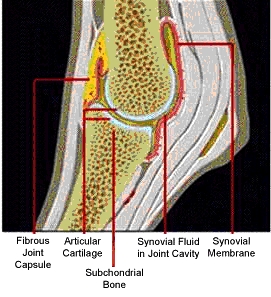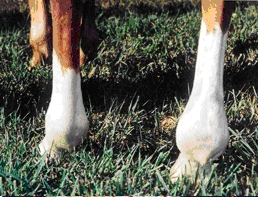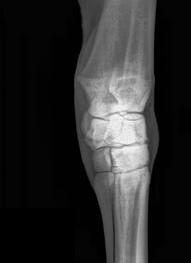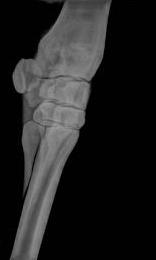Osteoarthritis, commonly shortened to just arthritis, is a condition common to all species, including humans and horses. ‘Osteo-’ refers to bone, ‘arthro-’ refers to joints and ‘-itis’ means inflammation. Therefore, the term osteoarthritis means inflammation of bone and joints, which is exactly what the disease is. It is also known as degenerative joint disease, or DJD for short.
Osteoarthritis is a very complex disease that affects a large proportion of the horse population. Young horses can be affected as well as older horses. A history of low-grade lameness, which the horse warms out of with exercise and is worse on cold mornings, is strongly suggestive of arthritis. A lameness examination, including nerve and joint blocks, followed by radiographs, confirms the diagnosis. Based upon the severity of the clinical signs, the severity of the changes on x-rays, and the use of the horse, the most appropriate treatment regime can be developed. Treatment will not reverse the changes present, but is aimed at reducing the rate of progression of the disease, rendering the joint pain-free, and prolonging the athletic career of the horse. The response to treatment can be a very individual horse-thing, so it can take some time to find what treatments and management work best for each individual horse. Arthritis can be a career-ending problem, but it is not often that a horse has to be euthanized for arthritis, they can usually be kept comfortable enough to live out their days in a paddock.
- Causes
A joint is the junction between two or more bones of the skeleton. Bone is rich in nerves, and if two bones are in direct contact and rub against each other, this is very painful. Therefore, cartilage covers the ends of the bones, which does not contain nerves, and separates the bones. Synovial fluid is contained within the joint, which acts as a lubricant to allow the bones to move freely within the joint. The synovial membrane produces the synovial fluid, and encloses the joint to keep the fluid within the joint. Outside the synovial membrane is the fibrous joint capsule, and outside of this are other soft tissue structures, such as ligaments, including collateral ligaments, and muscles. These are responsible for stabilising the joint and keeping the two ends of the bones together; if these structures fail, dislocation of the joint occurs.

- In people, osteoarthritis is classified into two categories, primary osteoarthritis, which has no known cause, and secondary osteoarthritis, which is osteoarthritis that occurs secondary to a known cause. Primary osteoarthritis can also be further subclassified into osteoarthritis associated with high-motion joints, such as the knee (carpus), and osteoarthritis associated with low-motion joints, such as the pastern. Predisposing factors that can lead to secondary osteoarthritis include fractures of the bones that involve the joint; soft tissue injury, such as ligament strains and damage to the joint capsule; wounds overlying the joint; infection of the joint; and a joint disease known as osteochondrosis which affects young horses. Poor conformation is also a predisposing factor for osteoarthritis due to uneven loads applied to each side of the joint.
- Regardless of the cause, known or unknown, the joint becomes inflamed and this results in destruction of the cartilage within the joint. The joint is a ‘protected’ area, meaning that entry and exit of factors from the joint is highly regulated. When the synovial membrane becomes inflamed, it loses its ability to carefully regulate this process, and factors can enter the joint that are normally kept outside of it. Non-specific mediators of inflammation enter the joint and produce a cascade of effects resulting in the activation of specific mediators that destroy cartilage. If these mediators overwhelm the inhibitory factors present in the joint, the net result is cartilage destruction, particularly in areas of increased load, such as the front of the knee compared to the back of it. Loss of cartilage results in exposure of the underlying bone, which also becomes inflamed, and this is one source of pain in arthritis, as bone is rich in nerves. The fibrous joint capsule also contains nerves, and is another source of pain when inflamed.
- There are two main clinical signs associated with arthritis: pain, exhibited as lameness, and effusion (swelling) of the joint. The two signs do not always occur together initially, but as the condition progresses both become apparent. Lameness may be subtle initially, and may present as the horse being reluctant to perform certain activities/movements, such as refusing jumps, through to overt lameness present at the trot or even at walk. Effusion of the joint results from the accumulation of synovial fluid within the joint, due to increased production and decreased removal.

- Consequently, pouches of the joint that are not usually apparent become more prominent. The very observant owner may also notice that the horse has a reduced range of motion associated with the affected joint, but this will be picked up by the vet on examination. Upon questioning the owner, many horses with arthritis are reported to be lame at the start of exercise, but warm out of it, and are often stiff or lamer on cold and/or damp mornings.
- Diagnosis involves identifying the joint or joints responsible for causing the lameness, through a lameness examination, which involves trotting the horse, flexing the joints, and performing nerve and joint blocks as necessary. Ideally, local anaesthetic is placed into the joint and the lameness should improve by seventy percent or more, to confirm that joint as the cause of the lameness. The next step is to take radiographs (x-rays) of the affected joint. Findings on radiographs suggestive of osteoarthritis include:
- Osteophyte (‘bone spur’) formation - Osteophytes are outgrowths of bone, which usually occur along the joint margins
- Subchondral bone resorption or schlerosis - The bone underlying the cartilage, which is destroyed, reacts by decreasing or increasing in density
- Narrowing of the joint space due to destruction of the articular cartilage
- Periarticular new bone formation - The formation of new bone outside of the joint in response to inflammation within the joint
Radiographs are only able to detect abnormalities of bone, as cartilage is not visible on radiographs. Although you would expect the severity of the radiographic findings to correlate with the degree of lameness and effusion, this is not always the case. For example, there may be minimal bony changes apparent on radiographs,  but significant cartilage destruction present, and vice versa. A further diagnostic tool that is indicated in some cases is arthroscopy, where a camera is inserted into the joint to look directly at the cartilage and assess the degree of damage. This involves surgery, so is an expensive technique and there are the risks associated with anaesthetising a horse. At the same time it is possible to flush the joint to remove some of the inflammatory mediators and ‘tidy up’ the joint.
but significant cartilage destruction present, and vice versa. A further diagnostic tool that is indicated in some cases is arthroscopy, where a camera is inserted into the joint to look directly at the cartilage and assess the degree of damage. This involves surgery, so is an expensive technique and there are the risks associated with anaesthetising a horse. At the same time it is possible to flush the joint to remove some of the inflammatory mediators and ‘tidy up’ the joint.
Treatment Options
The aims of treating osteoarthritis are:
- To remove any underlying cause
- To halt the progression of the disease process
- To enable return of the horse to its previous athletic function, by making the joint pain-free.
Regardless of the choice of treatment, it is important to rest the horse for a suitable period to reduce trauma to the joint from movement, reducing inflammation within the joint. In the event of an acute flare-up, stall rest is indicated, but for more chronic signs paddock rest is indicated to keep the joint flexible. However, rest alone is generally not enough to enable a horse to return to its previous use.
Phenylbutazone (‘bute’) is often used in horses with osteoarthritis. It is an anti-inflammatory and pain killer. Therefore, it reduces the inflammation within the joint and reduces the pain associated with that inflammation. Unfortunately it has to be given twice daily, and does not have any lasting beneficial effects on the joint, so once it is out of the system its effects cease. It is useful in the initial stages of an acute flare-up of osteoarthritis, or for horses that are only mildly affected and have the occasional ‘bad day’. There are some severe side-effects associated with long-term use of bute, including gastrointestinal ulceration, so it is only a short-term or intermittent solution.
Hyaluronic acid or hyaluronan is a normal constituent of cartilage and joint fluid. It can be injected directly into the joint, but there is always the risk of introducing infection into the joint when this is performed, or it can be injected intravenously. It is believed to facilitate lubrication of the joint, act as a local anti-inflammatory agent in the joint, and stimulate the production of normal joint fluid. Therefore, it slows the progression of osteoarthritis.
Polysulphated glycosaminoglycans (PSGAGs) are also normal constituents of the joint. Semisynthetic PSGAGs, such as Cartrophen® and Pentosan®, can be injected into the muscle to prevent and treat osteoarthritis. They bind to large molecules within the cartilage, protecting these molecules from damage caused by the degradative factors in the joint, as well as reducing the activity of these degradative factors. These drugs are also anti-inflammatory and they stimulate cartilage-producing cells to produce more of the components of cartilage.
Nutraceuticals are oral supplements designed to treat osteoarthritis. They contain combinations of cartilage components and their precursors, such as chondroitin sulphate and glucosamine. It is believed that these factors promote the synthesis of components of cartilage, such as hyaluronic acid, as well as having anti-inflammatory effects and inhibiting some of the enzymes that destroy cartilage. How useful these products are is questionable as they are administered orally and in theory should be destroyed in the gut before they can be absorbed, but some horse owners do think they help their horse.
Corticosteroids are potent anti-inflammatory agents, which significantly reduce the pain and swelling associated with osteoarthritis. They can be injected into the joint, or administered by the intravenous, intramuscular or oral routes. They are often injected directly into the joint, so a high concentration can be administered where they are needed and also to limit the side effects of corticosteroids on the rest of the body, such as laminitis. However, as mentioned before, injecting a joint does carry the risk of causing infection within the joint. Repeatedly injecting joints with corticosteroids is not a long term option as corticosteroids can be detrimental to the health of the joint by reducing normal cartilage metabolism, suppressing cartilage’s ability to repair itself after injury. Therefore, ultimately corticosteroids can contribute to the development of arthritis, but they can be very useful in prolonging the horse’s career by keeping them sound.
A novel therapy that is gaining popularity in Australia is known as IRAP, which stands for interleukin-1 receptor antagonist protein. It involves taking a sample of blood, incubating it in special syringes for 24 hours, harvesting the protein-rich serum and injecting this into the affected joint/s. During the incubation period the white blood cells in the blood are stimulated to produce anti-inflammatory agents, the main one being interleukin-1 receptor antagonist protein. Once injected into the joint, these agents exert an anti-inflammatory effect and stimulate a regenerative response by the cartilage cells. IRAP is relatively new, but early results indicate it can be very effective. However, it is not suitable for every case. It is best for those cases that have only mild to moderate osteoarthritis, whose lameness resolves in response to local anaesthetic in the affected joint, but where there are no or only mild changes on radiographs. It is quite expensive at this stage, and only a limited number of veterinary practices offer the service, as special equipment is needed.
There are numerous physical therapies that can be employed to help reduce the pain and inflammation associated with arthritis. Cold therapy (e.g. ice, cold hosing) is most beneficial after exercise. Heat therapy (e.g. poultices, bandages) is best if used before exercise, as it increases the local blood flow to the area, reducing joint stiffness. Magnetic boots are popular. The theory is that the electromagnetic stimulation increases the circulation at the treatment site, encouraging healing and reducing stiffness. Another popular technique is shock wave therapy. High frequency shock waves applied to the affected area are converted to energy, which is believed to improve cell function and promote repair of treated tissues.
Surgery tends to be reserved for young horses, particularly race horses, which have bone spurs that are at risk of fracturing. A camera is inserted into the joint via one portal, to evaluate the joint and allow the lesion to be visualised, and instruments are inserted into the joint via another portal, to remove the bone spur. Surgery is expensive, there are risks associated with surgery, and it is not appropriate for every case of osteoarthritis.
Osteoarthritis is a very complex disease that affects a large proportion of the horse population. Young horses can be affected as well as older horses. A history of low-grade lameness, which the horse warms out of with exercise and is worse on cold mornings, is strongly suggestive of arthritis. A lameness examination, including nerve and joint blocks, followed by radiographs, confirms the diagnosis. Based upon the severity of the clinical signs, the severity of the changes on x-rays, and the use of the horse, the most appropriate treatment regime can be developed. Treatment will not reverse the changes present, but is aimed at reducing the rate of progression of the disease, rendering the joint pain-free, and prolonging the athletic career of the horse. The response to treatment can be a very individual horse-thing, so it can take some time to find what treatments and management work best for each individual horse. Arthritis can be a career-ending problem, but it is not often that a horse has to be euthanized for arthritis, they can usually be kept comfortable enough to live out their days in a paddock.










